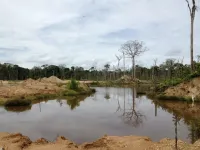(Press-News.org) MADISON, Wis. -- If you're wearing gold jewelry right now, there's a good chance it came from an illegal mining operation in the tropics and surfaced only after some rainforest was sacrificed, according to a team of University of Wisconsin-Madison researchers and alumni who studied regulatory efforts to curb some of these environmentally damaging activities in the Amazon.
The researchers, including UW-Madison geography Professor Lisa Naughton, investigated mining-related deforestation in a biodiverse and ecologically sensitive area of the Peruvian Amazon to see whether formalizing and legalizing these mining operations might curb some of their negative effects.
Their study, published June 2 in the journal Environmental Research Letters, was co-authored by a group including UW-Madison alumnae Nora Álvarez-Berríos, now studying land-use and climate impacts at the International Institute of Tropical Forestry, and Jessica L'Roe, now a geography professor at Middlebury College.
The team focused on an area around the Tambopata National Reserve in Peru from 2001 to 2014. During this time period, Naughton says, demand for gold rose, roads penetrated the region and mining surged. In turn, mining-related deforestation rose by almost 100,000 acres over their study period.
"Because the gold is in the sediment scattered under the forest floor, to extract the gold, you have to remove the forest and dig," Álvarez-Berríos says. "You have to cut a lot of the forest and excavate sensitive waterways."
While these mining operations are often called "artisanal" or "small-scale," in aggregate they are very destructive. In many countries they operate outside the law, and millions of people are involved across the tropics. Álvarez-Berríos says the typical first step to reducing the environmental impact of artisanal mining is bringing it under governmental oversight, formalizing the activity. That way, local agencies can manage the impacts and protect both ecologically sensitive areas and the economic well-being of poor mine workers.
"Peruvian authorities, like authorities in other gold-rush sites, have given up on trying to stop gold mining. They're trying to confine it and contain it," L'Roe says. "Most of the studies about formalization are mainly about trying to help the poor, or make it more fair for the poor. Seldom, almost never, as far as we can tell, have these formalization projects been assessed for their environmental impact. So that's what we were looking at."
During their study period, local agencies issued provisional titles to miners to conduct their operations safely. After receiving a provisional title, miners would, in theory, undergo a series of environmental impact and compliance assessments before they started work.
But, as L'Roe says they found, the regulation process took a long time. Many miners simply took their provisional title as a green light to start mining, and never went through with the environmental impact assessments. Over their study period, no mining operations made it through the full compliance process, and as such they found little evidence for improved environmental outcomes in formalized mining areas.
To assess environmental outcomes, the team used satellite imagery analysis to see how much of the forest had been cut down, as compared to areas without formalized mining regulations.
Naughton says while formalizing mining has the potential to decrease environmental damage, it needs enforcement and regulations that match the local context. Formalization without environmental impact assessment or enforcement could just encourage more damaging and dangerous mining, or the expansion of these operations under the pretense that what they're doing is legal.
But gold rushes are exactly what they sound like, Naughton says: rushed. They're fast, and slow formalization processes with many steps and provisions and impact assessments often cannot keep up with the pace of extraction.
"To sort out in a fair way who owns what land, with what rights, that is a slow process," Naughton says. "This gold rush is explosive. By the time you have well-regulated and transparent public land and property rights, the forest will be gone."
The team plans to go back to Tambopata to present its results to local stakeholders. Many members of the community are already aware of the problems with mining formalization but have not had a chance to systematically study the environmental consequences. The three co-authors hope their study will set a precedent for monitoring formalization interventions in Tambopata and other tropical sites losing forest to mining. They are already sharing results and methods with colleagues concerned about gold mining impacts in Colombia, Brazil and Bolivia.
"We'll go back to our study site and share the results -- but in a humble way because folks there know that it hasn't worked well, and they know the problems," says Álvarez-Berríos. "So, yes, it's important to share it with that group of stakeholders and experts, but maybe even more important is to share the results and our methods and design for studying this problem with folks working in the many, many other areas where there's uncontrolled small-scale gold mining and where formalization efforts are being launched with best intentions."
INFORMATION:
Contacts: Lisa Naughton, naughton@geography.wisc.edu; Nora Álvarez-Berríos, nora.l.alvarez-berrios@usda.gov; Jessica L'Roe, jlroe@middlebury.edu
READ ON THE WEB: https://news.wisc.edu/uw-researchers-investigate-mining-related-deforestation-in-the-amazon/
DOWNLOAD PHOTO: https://uwmadison.box.com/v/artisanal-mining
In a large, international retrospective study, men at high risk for death from prostate cancer had a significant reduction in all-cause mortality if treated with radiation shortly after surgery.
Prostate cancer is one of the most common forms of cancer among men, and about 1-in-8 of them will be diagnosed with it during their lifetime. While most men are cured with available treatment, there remains a group at high risk for death. In the United States in 2020, 33,330 men died from the disease, making prostate cancer the second leading cause of cancer death for men in this country. Therefore, among those at highest risk of recurrence, metastasis, and death from prostate cancer, understanding what steps can be taken to lower these risks could save and extend lives.
Early ...
Oak Brook, IL - The June edition of SLAS Discovery features the cover article, "A Perspective on Synthetic Biology in Drug Discovery and Development--Current Impact and Future Opportunities" by Florian David, Ph.D. (Chalmers University of Technology, Gothenburg, Sweden), Andrew M. Davis, Ph.D. (AstraZeneca, Cambridge, England, UK). Michael Gossing, Ph.D., Martin A. Hayes, Ph.D., and Elvira Romero, Ph.D., and Louis H. Scott, Ph.D. (AstraZeneca, Gothenburg, Sweden), and Mark J. Wigglesworth, Ph.D. (AstraZeneca, London, England, UK).
In January 2021, a survey of immunologists, infectious-disease researchers and virologists found that 90% of respondents believe SARS-CoV-2 will become endemic, continuing to circulate in pockets of the global population ...
An international subject pool was studied to confirm the effectiveness of a whole food complete vitamin and meal replacement product, IQed. The article, co-authored by Lisa Geng; Francine Hamel, EdD, SLP-CCC; Doreen Lewis, Ph.D., appeared in the peer-reviewed journal, Alternative Therapies (Altern Ther Health Med 2021 Mar;27(2):11-20(.
The findings indicate that the carefully developed nutritional supplement, IQed Smart Nutrition, can help bolster key functions for people with a wide range of prevalent diagnoses including Autism, Apraxia, ...
Oak Brook, IL - The June edition of SLAS Technology is a Special Issue entitled, "Emerging Trends in 3D Cell Culture: High-Throughput Screening, Disease Modeling and Translational Medicine." Free online access to the articles in this collection is courtesy of Corning Life Sciences, the issue's sponsor.
Precision medicine is becoming an increasingly popular and powerful way to target and treat human diseases. Patient-derived cellular models ushered in high-throughput screenings (HTS) in laboratory automation. While the upkeep and expansion of cells for HTS is predominantly manual, this special issue explores an automated avenue for HTS in research settings that considers the expansion of cells. This design is flexible for research and development ...
At Boston University, a team of researchers is working to better understand how language and speech is processed in the brain, and how to best rehabilitate people who have lost their ability to communicate due to brain damage caused by a stroke, trauma, or another type of brain injury. This type of language loss is called aphasia, a long-term neurological disorder caused by damage to the part of the brain responsible for language production and processing that impacts over a million people in the US.
"It's a huge problem," says Swathi Kiran, director of BU's Aphasia Research Lab, and College of Health & Rehabilitation Sciences: Sargent College associate dean for research and ...
The new drug sotorasib reduces tumor size and shows promise in improving survival among patients with lung tumors caused by a specific DNA mutation, according to results of a global phase 2 clinical trial. The drug is designed to shut down the effects of the mutation, which is found in about 13% of patients with lung adenocarcinoma, a common type of non-small-cell lung cancer.
The Food and Drug Administration approved sotorasib May 28 as a targeted therapy for patients with non-small-cell lung cancer whose tumors express a specific mutation -- called ...
PROVIDENCE, R.I. [Brown University] -- A new study of monsoon rainfall on the Indian subcontinent over the past million years provides vital clues about how the monsoons will respond to future climate change.
The study, published in Science Advances, found that periodic changes in the intensity of monsoon rainfall over the past 900,000 years were associated with fluctuations in atmospheric carbon dioxide (CO2), continental ice volume and moisture import from the southern hemisphere Indian Ocean. The findings bolster climate model predictions that rising CO2 and higher global temperatures will lead to stronger monsoon seasons.
"We show that over the last 900,000 years, higher CO2 levels along with associated changes in ice volume and moisture ...
Accurate soft tissue measurements are critical when making reconstructions of human ancestors, a new study from the University of Adelaide and Arizona State University has found.
"Reconstructing extinct members of the Hominidae, or hominids, including their facial soft tissue, has become increasingly popular with many approximations of their faces presented in museum exhibitions, popular science publications and at conference presentations worldwide," said lead author PhD student Ryan M. Campbell from the University of Adelaide.
"It is essential that accurate facial soft tissue thickness measurements are used when reconstructing the faces of hominids to reduce the variability exhibited in reconstructions of the same individuals."
Hominids have been readily accepted ...
A new study shows that substantial amounts of carbon dioxide were released during the last millennium because of crop cultivation on peatlands in the Northern Hemisphere.
Only about half of the carbon released through the conversion of peat to croplands was compensated by continuous carbon absorption in natural northern peatlands.
Peatlands are a type of wetland which store more organic carbon than any other type of land ecosystem in the world.
Due to waterlogged conditions, dead plant materials do not fully decay and carbon accumulates in peatlands over thousands of years.
Therefore, natural peatlands help to cool the climate by capturing carbon dioxide (CO2) from the atmosphere ...
ABSTRACT #9003
HOUSTON - Results from the Phase II cohort of the CodeBreaK 100 study showed that treatment with the KRAS G12C inhibitor sotorasib achieved a 37.1% objective response rate and 12.5 months median overall survival in previously treated patients with KRAS G12C-mutated non-small cell lung cancer (NSCLC), according to researchers from The University of Texas MD Anderson Cancer Center. The findings were presented today at the 2021 American Society of Clinical Oncology (ASCO) Annual Meeting and published in the New England Journal of Medicine.
Trial results indicated the targeted therapy was safe and tolerable in a heavily pre-treated patient population. The reported findings make sotorasib the first KRAS G12C inhibitor to demonstrate overall survival benefit in a registrational ...



